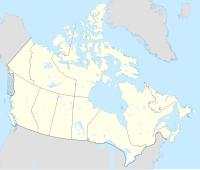Lake Alma
Lake Alma | |
|---|---|
Special service area | |
 Lake Alma Location of Lake Alma | |
| Coordinates: 49°08′41″N 104°11′51″W / 49.14472°N 104.19750°WCoordinates: 49°08′41″N 104°11′51″W / 49.14472°N 104.19750°W | |
| Country | Canada |
| Province | Saskatchewan |
| Region | Southeast |
| Census division | 2 |
| Rural municipality | Lake Alma |
| Incorporated (village)[1] | January 1, 1949 |
| Dissolved (special service area)[2] | July 31, 2018 |
| Government | |
| Area | |
| • Total | 0.47 km2 (0.18 sq mi) |
| Population (2016) | |
| • Total | 30 |
| • Density | 64.4/km2 (167/sq mi) |
| Time zone | UTC-6 (CST) |
| Postal code | S0C 1M0 |
| Area code(s) | 306 |
| Highways | |
Lake Alma is a special service area within the Rural Municipality of Lake Alma No. 8, Saskatchewan, Canada that held village status prior to August 2018. The community shares its name with nearby Alma Lake and surrounding rural municipality. Lake Alma had a population of 30 in the 2016, 2011 and 2006 Censuses).
History[]
Lake Alma incorporated as a village on January 1, 1949.[1] It restructured on July 31, 2018, relinquishing its village status in favour of becoming a special service area under the jurisdiction of the Rural Municipality of Lake Alma No. 8.[2]
Demographics[]
| hideCanada census – Lake Alma community profile | |||
|---|---|---|---|
| 2016 | 2011 | 2006 | |
| Population: | 30 (0.0% from 2011) | 30 (0.0% from 2006) | 30 (-14.3% from 2001) |
| Land area: | 0.47 km2 (0.18 sq mi) | 0.47 km2 (0.18 sq mi) | 0.47 km2 (0.18 sq mi) |
| Population density: | 64.4/km2 (167/sq mi) | 64.4/km2 (167/sq mi) | 64.4/km2 (167/sq mi) |
| Median age: | |||
| Total private dwellings: | 17 | 22 | 23 |
| Median household income: | |||
| References: 2016[3] 2011[4] 2006[5] earlier[6] | |||
See also[]
- List of communities in Saskatchewan
- List of special service areas in Saskatchewan
References[]
- ^ Jump up to: a b "Urban Municipality Incorporations" (PDF). Saskatchewan Ministry of Government Relations. p. 7. Archived from the original on October 15, 2014. Retrieved October 13, 2019.
- ^ Jump up to: a b "Restructuring of the Village of Lake Alma" (PDF). The Saskatchewan Gazette. June 22, 2018. pp. 1438–1440. Retrieved October 12, 2019.
- ^ "2016 Community Profiles". 2016 Canadian Census. Statistics Canada. February 21, 2017. Retrieved 2017-03-15.
- ^ "2011 Community Profiles". 2011 Canadian Census. Statistics Canada. July 5, 2013. Retrieved 2012-10-14.
- ^ "2006 Community Profiles". 2006 Canadian Census. Statistics Canada. March 30, 2011. Retrieved 2011-02-20.
- ^ "2001 Community Profiles". 2001 Canadian Census. Statistics Canada. February 17, 2012.
Categories:
- Lake Alma No. 8, Saskatchewan
- Special service areas in Saskatchewan
- Former villages in Saskatchewan
- Populated places disestablished in 2018
- Division No. 2, Saskatchewan
- Saskatchewan Division No. 2 geography stubs


